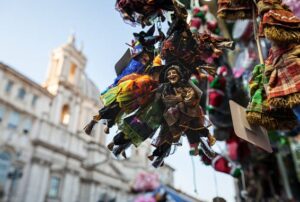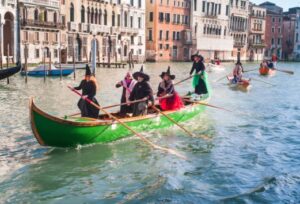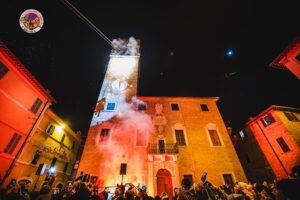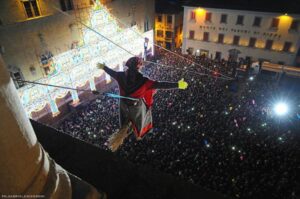La Befana: Italy’s Epiphany Tradition and Celebrations Across Italy
by Adriana ruiz
In Italy, the festive season extends beyond Christmas, culminating in the celebration of Epiphany on January 6th. A central figure in this unique Italian tradition is “La Befana,” a mysterious character that adds an extra touch of enchantment to the holiday season. Let’s explore the origins of La Befana, her fascinating role in Italian folklore, how similar traditions unfold in other parts of the world, and celebrations to welcome La Befana across cities in Italy.
Every year, on the night of January 5, Italian children eagerly await the arrival of La Befana, a kindly old woman who brings them gifts and sweets. According to tradition, she fills the socks of good children with candy and toys, while the bad ones get coal. But who is La Befana, and why is she associated with a witch?
The name La Befana comes from the word Epifania, which is the Italian name for the Feast of Epiphany, a Christian celebration of the visit of the Three Wise Men to the baby Jesus. According to one legend, La Befana was a woman who lived near Bethlehem and was visited by the Three Wise Men on their way to see Jesus. They invited her to join them, but she refused, claiming she was too busy with her housework. Later, she regretted her decision, tried to follow them, but could not find them. She wandered around the world, looking for Jesus and giving gifts to good children along the way.
Another legend says that La Befana was a mother who lost her child and went mad with grief. When she heard about the birth of Jesus, she thought he was her son and went to see him, bringing him gifts. Jesus was happy with her gesture and blessed her, making her the mother of all Italian children.
La Befana is often depicted as a hag riding a broomstick, wearing a black shawl and a patched dress, and carrying a sack of gifts. Covered in soot because she enters houses through the chimney, she is also a good housekeeper, sweeping the floor before she leaves. She fills children’s stockings with candy, fruit, nuts, or toys if they are good, or coal, garlic, or onions if they are bad. Families also prepare a small glass of wine and some food for her.
La Befana is a popular figure in Italian folklore and culture, and her tradition dates back to ancient times when pagan rites of fertility and renewal were celebrated around the winter solstice. Some scholars believe that La Befana is a Christian adaptation of an earlier Roman goddess, Strenia, associated with the new year and the gift of branches. Others suggest that La Befana has Celtic origins, resembling some of their female deities of nature and magic.
La Befana is not the only gift-bringer in Europe. Many other characters play a similar role, such as Santa Claus, Father Christmas, Saint Nicholas, the Christkind, the Yule Goat, and the Three Kings. Each has their own history, customs, and symbols, but they all share the same spirit of generosity, joy, and love.
La Befana’s Celebrations Across Italy

La Befana is celebrated in many parts of Italy with festivals, parades, bonfires, and markets. One of the most famous events is held in Piazza Navona in Rome, where a large market offers sweets, toys, decorations, and other items related to La Befana. On January 6, La Befana will arrive at the square at 12:00 and greet the children until 14:00, distributing candy and small gifts to the crowd.
Other events in Italy where La Befana will arrive in the year 2024 include:

1. The Befana Race in Venice, where hundreds of people dressed as La Befana row along the Grand Canal on boats and gondolas. The departure will be at 10:00 AM from S. Tomà to the Rialto Bridge.
2. The Befana Festival in Urbania, where La Befana has her official home and receives thousands of letters from children every year. The festival features shows, games, workshops, and a giant sock that can hold up to 10,000 gifts. La befana will arrive at 13:00 at Piazza del comune. The entrance fee for those older than 11 years old and non-residents is 6€.
3. The Befana descends from the Campanile in Pistoia. On January 6th, the meeting point is in Piazza Duomo, where La Befana will descend from the bell tower of the Torre Catilina to distribute gifts and sweets to all children. The entire square will be adorned with 12 large stockings, placed on the walls of the buildings. Access to Piazza Duomo will be allowed exclusively from Ripa della Comunità and via Roma. Starting from 3:00 PM, it will be possible to enter the square for free, up to the limit set by safety regulations.
Read more about:
Italian New Year’s Eve Traditions
Epiphany Festival at Piazza Navona, featuring Activities for Children
Free entry to museums and archaeological sites in Italy on the first Sunday of each month
15 Must-Visit Museums, Galleries, and Cultural Sites in Italy
Enjoy the holiday season with a visit to Rome’s ice skating rinks
Visit the exhibition of ‘100 Nativity Scenes in the Vatican’ for FREE
Don’t forget to check out our Social Media accounts and Subscribe to our Newsletter so you can be updated with information customized for people who want to move, live, and love Italy! Also, check out these unique tours in Rome.
FAQs for Italian Citizenship by Marriage (2023)
Understanding the Tessera Sanitaria: Your Italian Health Insurance Card
Non-Married Partners: How to Obtain a Residence Permit in Italy as De Facto Cohabitants
How to get tax identification number for foreign citizens (Codice Fiscale)
How to register in Italy as an EU citizen
Mastering Public Transport in Italy
The Advantages of Dual Citizenship with an Italian Passport: Unlocking Boundless Opportunities
What you need to know about Visas and Permits to stay in Italy







Leave a Comment:
You must be logged in to post a comment.